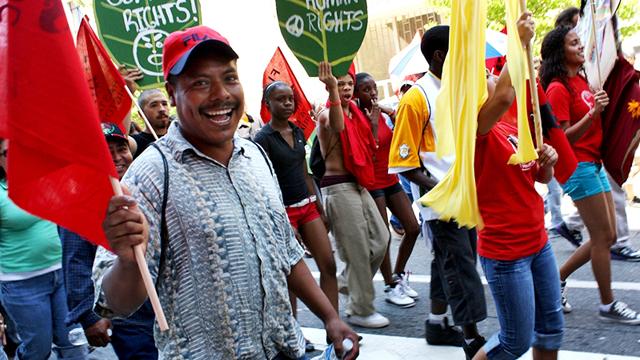
2012 was an exciting year for organized labor as well as worker’s rights, generating a lot of excitement that 2013 could hold even more. Protecting the rights of all workers and creating a safer, more productive, healthier working environment is key not just to human rights, but also to economic recovery in the U.S. Could 2013 be the year in which organized labor becomes a powerful force in U.S. politics and society again, after years of being pushed to the margins?
Strikes and walkouts. From January to December, workers took to the streets in organized strikes as well as walkouts to demand better working conditions and educate the public. Hyatt housekeepers demanded safer conditions, JFK Airport employees raised concerns about security, fast food workers walked away from the counter in New York, and telecommunications employees highlighted problems with their contracts. All of these workers weren’t just fighting for better conditions for themselves (sometimes without even the protection of a union), but for a safer society, too; they pointed out that their poor working conditions endangered not just them, but the public.
More unionizing. Passenger service agents at American Airlines are voting right now on whether to form a union, and they’re not the only ones who are organizing to form or join unions. Across the U.S., workers are realizing the value that union membership has to offer. When it comes to negotiating with employers, having the backing of an organized group can make the difference between failure and success.
Rising awareness of social inequality. Thanks to the surge of the Occupy movement, more and more people are aware of the huge wealth gap in the United States. Along with concerns about social inequality comes a corresponding interest in addressing that inequality; in the case of workers, organizing to improve wages and benefits as well as protect job security is key to making up the wealth gap. Unions and labor organizers are committed to helping all workers achieve their dreams, and directly address the obstacles that lie in the way, such as unacceptably low minimum wage, poor working conditions and sexual harassment in the workplace.
The value of solidarity. In a year when the country was rocked by multiple tragedies, the U.S. public was reminded of the value of coming together as a community, and of how much work could be accomplished by lending many hands to even the most difficult of tasks. From Occupy Sandy working to help Sandy victims to volunteers traveling across country to lend solace and expert skills to communities ravaged by rampage violence, Americans were reminded that it’s good to work together. The skills of experienced labor organizers and workers’ rights activists turned out to be key to developing quick and effective responses for communities in need.
More public outreach by unions. Recognizing that many members of the public didn’t fully understand the function and purpose of unions, a number reached out with public campaigns to educate people about what they do and the value they add to the lives of workers and the community. They provided information about the tasks performed by workers and how the union protects them as well as the public, in addition to illustrating the victories for all workers that have been accomplished by labor organizing. The goal was to make “union” something other than a dirty word in the minds of the public, sowing seeds for more organizing.
Especially in the wake of numerous attacks on workers, unions and organized labor in 2012 in several states, including the passage of “right to work” laws in Michigan, the need for advocates is more apparent now than ever. Could 2013 be the year in which the U.S. becomes union strong again?
3 WAYS TO SHOW YOUR SUPPORT
- Log in to post comments
















